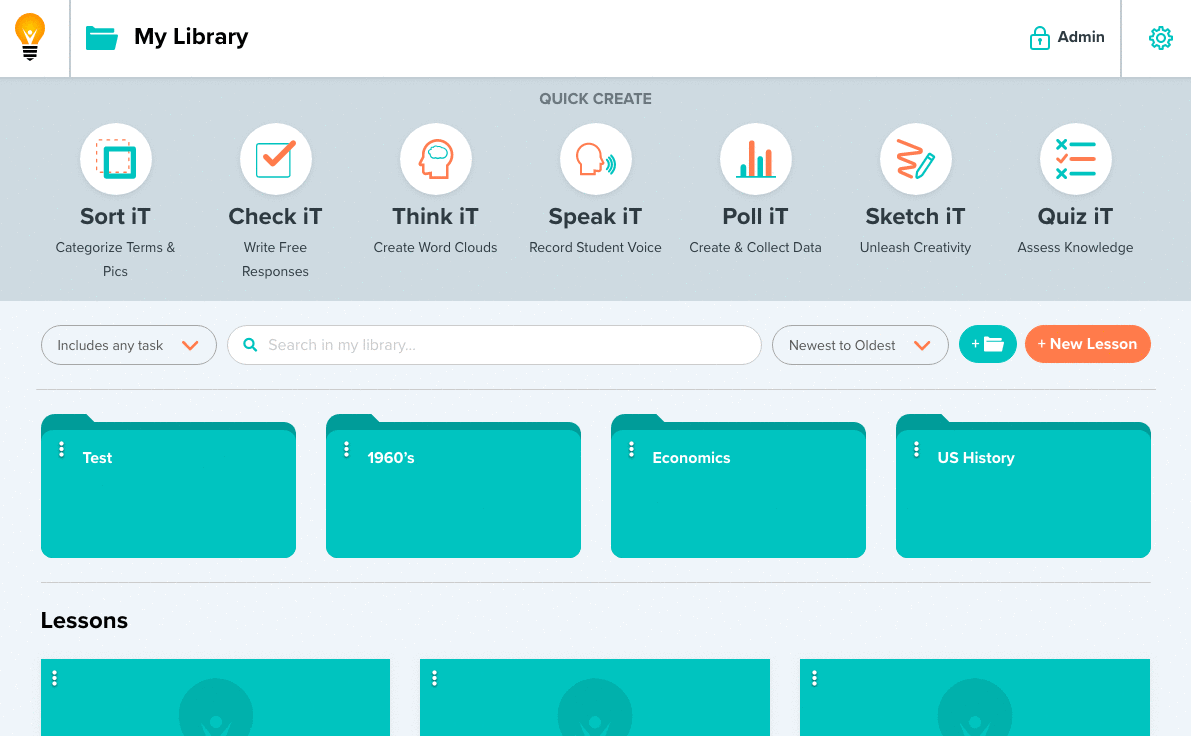How do I make a Sort iT? #
- Start by filling out the required fields including title, grade level, and subject.
- Next, create your different groups and title them accordingly. Under each group create terms to go along with it, these can be in the form of text, images, or math equations.
- Once you’ve created each group with terms to match, hit start to launch your lesson and share the lesson ID with your class to allow them to participate.

What can I use Sort iT for? #
Categorizing terms and content– Have students sort through content and categorize terms, concepts, and topics into as many or as few groups as you would like. Use the instant feedback to be responsive to the class by evaluating progress data based on category, term, or student.
Cause and effect relationships– Use Sort iT to establish cause and effect relationships, or to create an interactive demo that coincides with any topic in your unit. Use real-time data to determine if students have met your objectives and are ready to move on.
Classifying images– Reinforce the big ideas in your unit by creating sorting activities with a visual. Create a deck for any topic in any unit by using stock images or screen shots. Using Sort iT is a powerful way to deliver content to visual learners.
Vocabulary– Create the ultimate deck of flash cards by combining terms and images. Use the live data on each term to determine your next area of focus to ensure that every student obtains mastery on your most essential content.
How can I use Sort iT in an English Classroom? #
- Students can sort dynamic vs. static characters, main vs. secondary characters.
- Students can do a concept sort for new, important vocabulary or terms. Ex: when learning pieces of the author’s craft, poetic devices, or parts of speech.
- When teaching writing, students can group similar ideas together to help with teaching organization of paragraphs.
How can I use Sort iT in a Science Classroom? #
- Have students categorize symbols, key terms, domain specific words.
- Students can show relationships among key terms, or items. For example, when teaching forces and interactions (ex: force, friction, reaction force, energy) have students sort to demonstrate higher level thinking.
- Students can classify the hierarchy of biological classification of genus versus species to demonstrate understanding of the differences.
How can I use Sort iT in a Math Classroom? #
- Have students categorize precise terms around proofs. Ex: which properties can be used to prove Pythagoras’s Theory.
- Students can do a concept sort for new, important vocabulary or terms. Ex: when teaching functions, have students sort and classify terms such as axis, linear, value, etc. to show related properties.
- To demonstrate reasoning, students can sort sets or theories. Ex: number facts, ratios, fractions, prime vs. even numbers, etc. to demonstrate attainment and understanding.
How can I use Sort iT in a Social Studies Classroom? #
- Students can sort terms associated with each era (Ex: Paleolithic area would receive the terms “hunter and gatherers” to show gender roles, Neolithic would receive the word “farming”). This sorting would allow students to demonstrate the knowledge they gained on each era, while also being able to compare and contrast.
- Students can do a concept sort for new, important vocabulary or terms. Ex: when teaching religions, have students sort and classify terms such as monotheism, Four Noble Truths, Five Pillars of Faith, the Koran, etc.). Students can determine categories to demonstrate critical thinking skills.
- When studying the three prominent Enlightenment thinkers (Locke, Rousseau, Montesquieu) , students can sort the ideas that belong to each person.






Leave a Reply
You must be logged in to post a comment.